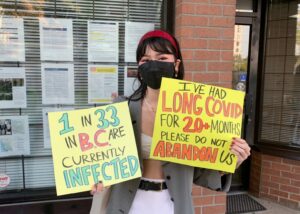By: Gabrielle McLaren, Editor-in-Chief
I know that waiting until your last year to hit your Q/B-Sci requirements is the ultimate Arts-student crime, but I paid for it dearly by ending up in BPK140 C200: Contemporary Health Issues. I thought this online class would be easier to balance with my two summer jobs and relate to topics I cared about. I was wrong.
Every week the assigned reading, from a textbook written specifically for the class by professor Stephen Brown (an SFU alum), and published by SFU Publications, had me gawking in disbelief. For the purpose of this piece, let’s just look at some things that made me cringe from the chapters about sex, sexual health, and intimacy.
- On page 262, the textbook claims that the diaphragm protects against sexually transmitted illnesses (STIs). This is something that a quick confirmation check in an all-uterus-bearer group chat and a trip to Planned Parenthood’s website confirmed as incorrect.
- A list of “Variations in Sexual Behaviour” that starts on page 219 lumps together rape, sex with children, masturbation, oral sex, anal intercourse, and homosexuality. I had to take a break when I saw this. Brown acknowledges that homosexuality used to be legally persecuted, but doesn’t see the problem with listing queerness alongside “rape” and “sex with children”? Not differentiating between healthy sex and criminal sexual behaviour, especially when a marganialized community is thrown in the mix, is tone deaf, foolish, and unacceptable.
- While I’m at it, Brown has no business discussing the biological determinism of queer desire and linking “low blood levels of testosterone and other male hormones” to gay men’s development. Studies looking for a “gay gene” have faced significant criticism as early as 1995, and the politics surrounding them are too crucial to ommit. Plus, at surface level, why would you just drop in a textbook that gay men are gay because they’re less manly than other men? Come on. Think of the top five existing prejudices against gay men and tell me why you’re reinforcing this without providing appropriate context.
- As you can probably tell, the book was the most cisheteronormative thing I’ve seen since Catholic school. The in-depth discussion of the mechanics of penis-vagina sex has no queer equivalent. Asexuality is never addressed as a normal, healthy sexuality. Even language such as “female condom” instead of the inclusive (and frankly more accurate) “internal condom” constantly flags to students whose sexuality is cared about most.
- Pages 263 to 265 are dedicated to showing how to respond to a partner who doesn’t want to use protection. The catch? The person giving excuses was always “Your Boyfriend,” implying the “You” to be a woman. The implication here is that safer sex is a heterosexual affair and a woman’s responsibility, especially since the text finishes with: “If your partner refuses to wear a latex condom, you use a female condom. Some men have said that sensation is not so reduced with a female condom.”
This isn’t a comprehensive list. We literally don’t have space and I’m not strong enough to relive that class. I haven’t even touched on how uncomfortable I was with the chapters on mental health or substance use. Additionally, someone from the Gender, Sexuality, and Women’s Studies department should have helped write the chapters about pornography, sex work, and abortion.
I understand this class is designed as a survey, but that simply can’t be an excuse for presenting simplistic, incomplete, or dated information to a university-level class. This class is the poster child for all those pesky claims that science can’t function without its social equivalent. I was anxious about having to repeat some of this content on an exam, for my GPA’s sake, knowing that it was wrong, incomplete, or problematic. As a queer woman with strong politics and outside knowledge, I worried about the first years who would trustingly internalize this class’ implicit messages.
I have no idea who oversees the content, tone, and quality of online classes and how or why they possibly let this happen. All evidence points to this class being spat out, packaged, and distributed to students for $192.03 a credit without a second thought. This class wasn’t boring or difficult — it was inaccurate and disrespectful. It needs to be pulled from course offerings and reworked; right now, it reflects poorly on CODE, BPK, and SFU as a whole.














